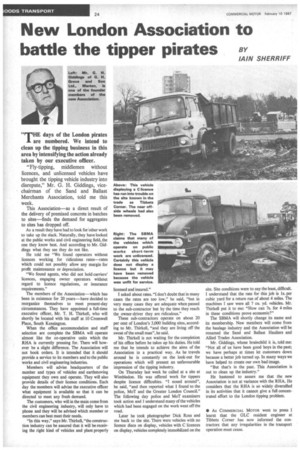New London Association to battle the tipper pirates
Page 26

If you've noticed an error in this article please click here to report it so we can fix it.
BY IAIN SHERRIFF
HE days of the London pirates I. are numbered. We intend to clean up the tipping business in this area by intensifying the action already t.aken by our executive officer.
"Fly-tipping, middlemen without licences, and unlicensed vehicles have brought the tipping vehicle industry into disrepute," Mr. G. H. Giddings, vice chairman of the Sand and Ballast Merchants Association, told me this week.
This Association—as a direct result of the delivery of premixed concrete in batches to sites—finds the demand for aggregates to sites has dropped off.
As a result they have had to look brother work to take up the slack. Naturally, they have looked at the public works and civil engineering field, the one they know best. And according to Mr. Giddings what they see they do not like.
He told me "We found operators without licences working for ridiculous rates—rates which could not possibly allow any margin for profit maintenance or depreciation.
"We found agents, who did not hold carriers' licences, engaging owner operators without regard to licence regulations, or insurance requirements."
The members of the Association which has been in existence for 20 years—have decided to reorganize themselves to meet present-day circumstances. They have appointed a full-time executive officer, Mr. T. H. Thirkell, who will shortly be located with his staff at 10 Cromwell Place, South Kensington.
When the office accommodation and staff selection are complete the SBMA will operate almost like the co-operative units which the RHA is currently pressing for. There will however be a slight difference. The Association will not book orders. It is intended that it should provide a service to its members and to the public works and civil engineering industries.
Members will advise headquarters of the number and types of vehicles and eartlunoving equipment they own and operate. They will also provide details of their licence conditions. Each day the members will advise the executive officer what equipment is available so that it can be directed to meet any fresh demand.
The customers, who will in the main come from the civil engineering industry, will only have to phone and they will be advised which member or members can best meet their needs.
"In this way," says Mr. Thirkell, "the construction industry can be assured that it will be receiving the right kind of vehicles and plant properly licensed and insured."
I asked about rates. "I don't doubt that in many cases the rates are too low," he said, "but in very many cases they are adequate when passed to the sub-contractor but by the time they reach the owner-driver they are ridiculous."
These sub-contractors operate on about 20 per cent of London's 3,000 building sites, according to Mr. Thirkell, "and they are living off the sweat of the small man", he said.
Mr. Thirkell is not waiting for the completion of his office before he takes up his duties. He told me that he intends to achieve the aims of the Association in a practical way. As he travels around he is constantly on the look-out for operations which will present an unfavourable impression of the tipping industry.
On Thursday last week he called at a site at Wimbledon. He was offered work for tippers despite licence difficulties. "I nosed around", he said, "and then reported what I found to the police. MoT and the Greater London Council." The following day police and MoT examiners took action and I understand many of the vehicles which had been engaged on the work went off the road.
Later he took photographer Dick Ross and me back to the site. There were vehicles with no licence discs on display, vehicles with C licences on display, vehicles completely immobilized on the site. Site conditions were to say the least, difficult. I understand that the rate for this job is Is. per cubic yard for a return run of about 4 miles. The machines I saw were all 7 cu. yd. vehicles. Mr. Thirkell put it to me: "How can 7s. for 4 miles in these conditions prove economic?"
The SBMA will shortly change its name and its membership. New members will come from the haulage industry and the Association will be renamed the Sand and Ballast Hauliers and Allied Trades Association.
Mr. Giddings, whose brainchild it is, told me: "Not all of us have been good boys in the past; we have perhaps at times let customers down because a better job turned up. In many ways we have helped to create our own bad image.
"But that's in the past. This Association is out to clean up the industry."
He hastened to assure me that the new Association is not at variance with the RHA. He considers that the RHA is sO widely diversified in its activities that it cannot give a full concentrated effort to the London tipping problem.
• AS COMMERCIAL MOTOR went to press I learnt that the GLC resident engineer at Tibbets Corner has now informed the contractors that any irregularities in the transport operation must cease.












































































































